Looking for the Preset Maker manual? Click Here
Kit Maker is a file organization app that can process samples and make ready-to-use kits for a variety of popular music programs. We are a third party software and not associated with any of the companies or DAWs mentioned below.
Note: Maschine Libraries are an accepted source of samples to convert for various kit presets, but Kit Maker does not create Maschine presets to be used inside the Maschine software.
Libraries
After choosing your library mode, drag Maschine Library or Sample Pack folders into the screen, or use the import button.

There are 2 forms of libraries Kit Maker can accept:
Maschine Library folders
(official Maschine / Native Instruments Expansion Libraries)
Sample Pack folders
(non-Maschine Sample Packs by various companies)
Before pressing “Make Kits”, select the correct library mode depending on which kind of library folder you are processing.
Multiple Maschine Libraries can be processed at once, or multiple Sample Packs can be processed at once, but you cannot process both forms of libraries together.
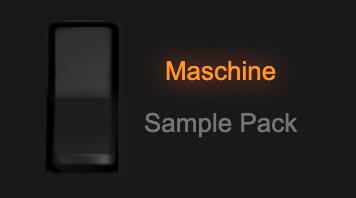
Note: The larger amount of files and libraries, the longer it will take to process. The moving gear animation on the screen shows that the app is still libraries. For Mac users, the app may temporarily say “Application Not Responding” while it is processing. This is normal when processing large volumes of files.
Maschine Library Mode
These folders are named after the Expansion title and are installed along with your other Native Instruments installed libraries. The Expansion folders typically have subfolders inside titled: Groups, Documentation, Projects, Samples, Sounds etc.
To import an expansion folder, drag the Expansion folder itself (such as “Amplified Funk”) into Kit Maker.
Note that these folders on Mac computers will often have the word “Library” at the end of them.
Kit Maker also works with the Machine factory library (titled “Maschine 2” or “Maschine 2 Library” and contains the subfolders mentioned above).
Note that unofficial third party libraries will not process correctly in Maschine mode and we do not advertise our app to do this. Please use official Expansions in Maschine Mode.
However, if you have the .wav samples, you are free to process them in Sample Pack Mode
The pad names in Maschine mode reflect the most common sounds in a typical Maschine kit. Each Maschine kit preset will be made using the same samples and kit name of the original Maschine Kit.
Where are these folders located?
In the Maschine app Preferences, go the the Library tab. Click on the small Directory icon next to the Maschine 2 Factory Library path. This will show the directory of the Factory Library. The Expansions are installed in the same location. More info on finding your Maschine Library locations can be found here.
For Mac users, the default Maschine Library install locations are in the Users/Shared directory.
Note: When using the Classic layout, the pads will be in a very similar order to the original kits as they appear in the Maschine software. The primary (orange labeled) pads will be in the same positions as the original Maschine kits, but some of the more obscure sample sounds may be in slightly different positions.
Having issues with your kits in Maschine Mode? View the Maschine Mode Help page!
Sample Pack Mode
Use Sample Pack mode to process any folder that contains organized folders of samples. Most Sample Packs include several folders that are named by category; these “keywords” determine how Kit Maker will lay out the samples on the pads of each kit.
ie; “Kick” pads will be filled with samples from the folder with “kicks” in its’ title.
Folder Keywords
By default, Kit Maker is set up with common keywords to organize your samples automatically. But if you want to organize them differently, you are free to edit the keywords in the Folder Keywords section of the Preferences.
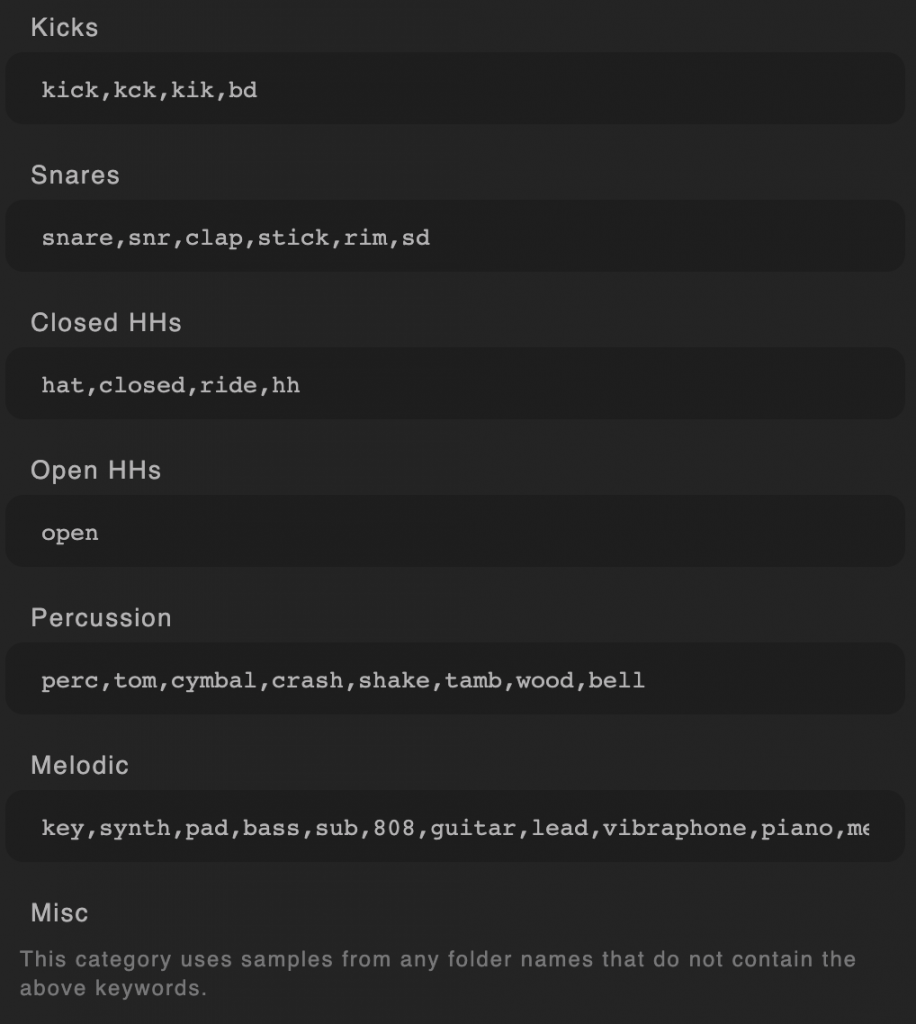
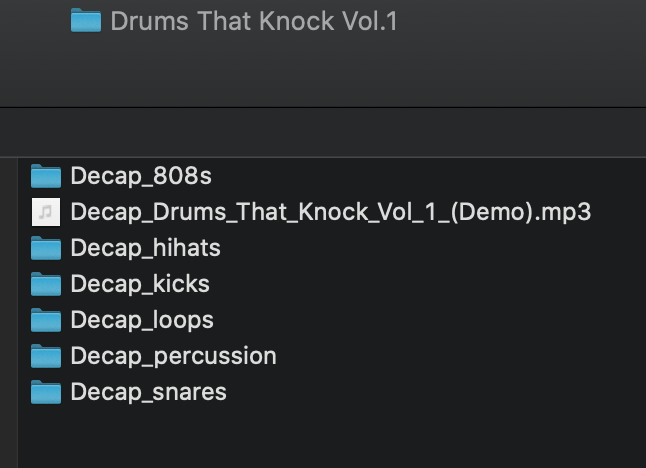
Make Your Own Sample Pack
If you have a Sample Pack that is not organized into categories of samples, or you want to put together your own Sample Pack, click the “Make Blank Sample Pack” button to make a blank Sample Pack folder to use.
Rename this folder anything you want but leave the sub-folders with their original titles.
Drag samples into the sub-folders inside.
These samples will later be placed on pads as they are labeled in the pad layout.

Although you can’t change the name of the pad categories in Kit Maker, you can use the pad categories for any type of sound you choose. The categories are merely suggestions.
Example:
If you primarily use electronic themed Sample Packs, you might not have any “Percussion” samples, but you can add “fx” to the Percussion categories keyword list (on the Folder Keywords page). The FX samples from your Sample Packs will now placed on pads labeled “Percussion”.
Filter Large Files
By default, large audio files (2mb or larger) are filtered out and skipped. This is because long, drawn-out audio samples typically are not the type of sounds producers want in their drum kits. However, if you want to allow all sizes of audio samples, you can disable this filter.
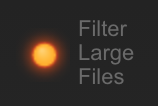
Fill All 16 Pads
By default, the “Fill All 16 Pads” option (found in Preferences) is enabled. This makes sure that every kit has 16 samples. Without this on, sample files will only fill pads of their own category (ie kick samples filling kick pads). Additionally, turning the option off will result in some kits having empty pads as samples of certain categories run out.
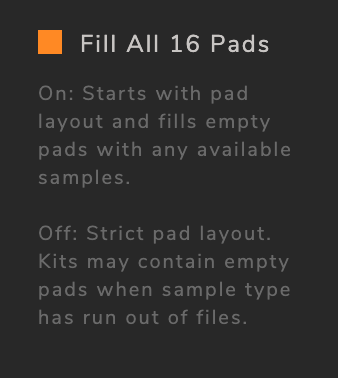
With the option on, a pad that ran out of samples for its’ category will be filled instead of being left empty. However, because that category of sound was out of samples (for example, there were no more closed kick sounds), a different sample type will be used to fill that otherwise empty spot (perhaps a closed hi hate sample will be used, if there are extra hi hat samples in that Sample Pack).
Turning Fill All 16 Pads Off
The benefit of turning this option off is that there will be more kits created (although with less samples per kit) and they will follow a more strict pad layout. For example, a user may have a Sample Pack that contains only kicks, snares and hi-hats. If they are just using these samples in their pattern, and want to make the most amount of kits to swap out and try different kit sounds, they may want to turn this option off.
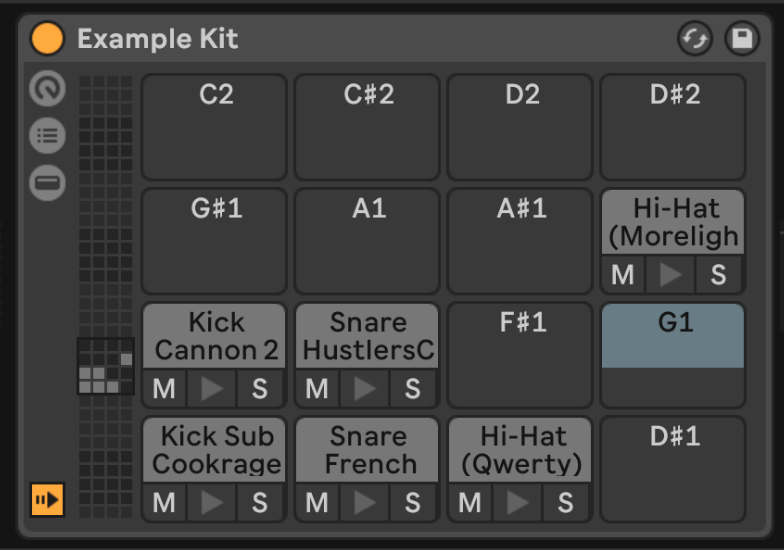
Samples will be placed on pads if the samples of that sound category are available. If there are no samples left of an individual pad’s category, other samples may be placed on that pad, as explained above.
Kits generated later in the process may have empty pads, as the available number of samples becomes less (ie; the kick samples have all been used in earlier kits and there are no kick samples left). Kit Maker will continue making kits until there are no samples left. Because there are an unlimited combination of samples a Sample Pack may contain, it is often the case that many of the later kits will not have the exact balance of samples to make full kits.
Tip: If your kits are ending up with too many empty pads, add more samples to the Misc folder.
The Misc category has a special ability. In addition to filling the original “Misc” labeled pads, left-over Misc samples will fill in otherwise empty pads. For example, if the first-generated kits use up all the hi-hat samples, these pads will end up being empty in later kits. But if there are extra Misc samples available, they will fill in the blanks.
See the Sample Pack Options section (lower in the manual) for more options on using Sample Packs.
Play around with different combinations of samples and options to see what works best for you!
Having issues with your kits in Sample Pack Mode? View the Sample Pack Mode Help page!
Note: Kit Maker can create kits using .wav, .aiff and .mp3 files. But keep in mind that certain software (Akai, for example) only accept .wav files.
Layouts and Customizing Kits
Choose a provided pad layout from the drop down, or drag and swap pad positions to create your own layout.
Press the Save button and Kit Maker will retain your Custom pad layout for future use.

Pad Labels
Pads labeled in orange are the primary pads. There can be a lot if variation in the types of samples that comprise each Maschine kit, but the primary pads are almost always the same throughout (two snares, two kicks and a closed hi hat).
These also show up as orange in the Sample Pack pad layout. These happen to be the most important drum sounds. When making a layout, it can help to visualize where your main samples will be.
Brighter labels indicate pads that take priority. In a Maschine kit, for example, there are often multiples of the same sample type, such as “Kick 1” and “Kick 2”. The brighter pad label indicates the first sample (“Kick 1” in this case).
When making Sample Pack kits, the same rule applies; the brighter pad will always be assigned first. In a case where Kit Maker only has one Kick sample left to use, for instance, it will be applied to the Kick pad with the brighter label.
Preferences
Maschine Library Options
These options affect how kits will be made when processing Maschine Libraries or Komplete Expansions (but will not affect kits made in Sample Pack mode)

Choke Hi-Hats
Automatically puts the primary closed Hi hat and Primary open Hi Hat in the same choke group.
This feature is Compatible with:
- Ableton,
- NanoStudio 2,
- MPC 2,
- MPC Modern Hardware & Akai Force
Not compatible BeatMaker 3, iMPC 2 or Numbered Files.
Group Toms
When a kit has 3 or more toms, they will be grouped together on the second row from the top.
On the Ergonomic and Classic layouts, the hi hats are moved one row lower.
Note: Works best with the Classic and Ergonomic layouts. If using your own custom layout pad order, the hi hats may show up in different places depending on how you have moved them.
Sample Pack Options

Number of Kits
Turn this on and enter an amount to limit the amount of kits generated. When turned off, kits will be generated until no samples are left.
Samples Per Kit
We recommend that most people stick to the default setup, but it is possible to experiment with the number of sample types assigned to each kit. For example, raising the amount of Kick samples from 2 per kit, to 4 per kit. The more you change these numbers, the less likely they will match up with the default pad labels. Given the vast possibilities of user-set sample amounts, the kits will come out less predictably.
Randomize Samples
By default, samples are filled alphabetically. For example a file named “A Kick.wav” will be used before “B Kick.wav.”
With Randomize Samples enabled, the samples for each category are randomized. This does not affect the pad layouts.
This option is useful when several samples are named similarly. For example, you may have several samples named something like “Bass 1.wav” all the way up to “Bass 12.wav”. Normally, Kit Maker will assign samples alphabetically. This would mean that all your “Bass” titled samples would be lumped together in a few kits, instead of having your Bass samples spread out across all your kits. The randomization option creates more diverse individual kits by avoiding grouping similar file names together.
Other Options
Re-enable Tutorials
This turns on the pop up instructions for using Sample Packs and making Ableton kits.
Ableton User Library
If you use a custom location for your Ableton User Library, click “Custom.” Then find and select the folder “User Library” in the file browser.
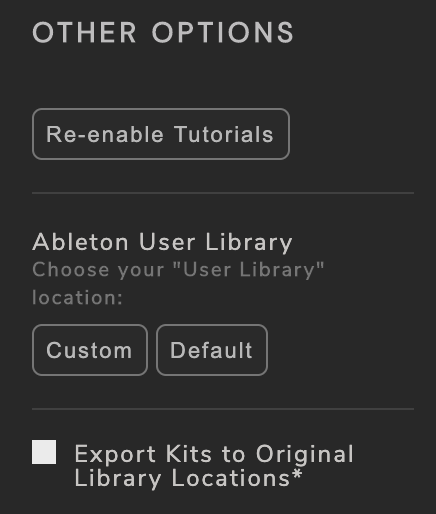
Export Kits to Original Library Locations
Kits are created on the Desktop by default. Enabling this option generates kits in the same directory as libraries you import. Note: If you import libraries from multiple locations, a “Kit Maker Kits” folder will be made for each respective location. This option does not apply to Ableton kits.
Check out this guide for making highly customized layouts!
Kit Formats
Deluge Kits
IMPORTANT: Deluge users will need to update to 2.3 or above, which fixes a compatibility error that began in a Deluge firmware update. Kits created after updating will work as expected.
Once you have created your drum kits for Deluge, follow these instructions on how to import them:
Copy the content of the “KITS” folder to the KITS folder of the Deluge.
Copy the folder “KIT MAKER” to the SAMPLES/DRUMS folder of the Deluge.
The path should be [SDCARD]/SAMPLES/DRUMS/KIT MAKER
If the KIT MAKER folder already exists on your Deluge, copy the contents of KIT MAKER to your existing KIT MAKER folder.
Beatmaker 3 (iOS)
View The Kit Maker: Beatmaker 3 Video for overview and instructions.
Transfer your Beatmaker kits to your iOS device. They will be ready to load as presets. Go to the Transferring to iOS Devices section (below in the manual) for more information, or watch the Beatmaker video provided.
Note: The format is bmk2 instead of bmk3 because of the encryption in the latter format. However, this does not affect the usability of the kits inside of Beatmaker 3.
When there is an empty pad, an “EMPTY.wav” file will be used, which is required for our app to make the bmk2 format.
The automatic Choke Hi-Hats option in the Kit Maker preferences does not apply to Beatmaker kits.
Beatmaker 3 accepted sample audio file formats: .wav
Nanostudio 2 (iOS)
View the Kit Maker: Nano Studio 2 Video for overview and instructions.
Transfer your Nanostudio 2 kits to your iOS device. They will be ready to load as presets. Go to the Transferring to iOS Devices section (below in the manual) for more information, or watch the Nanostudio 2 video provided.
iMPC Pro 2 (iOS)
View the Kit Maker: iMPC Pro 2 Video for overview and instructions.
Do not use the MPC .xpm format for iMPC 2 files. That preset is for the desktop app and the MPC hardware.
For iMPC 2 for iOS, use the Numbered Files option. It will create Folders of all your kits which you can import into the iMPC 2 folder of the Files app on your mobile device.
Import your kit folders using the iTunes file transfer. Then, in the Files app, drag the imported folders into the MPCPro folder. The kit folders will then show up in the iMPC 2 app. The folders themselves function as presets. See our video for more details.
In the iMPC 2 browser, simply hold and drag a kit folder to Pad 1 (the bottom left pad) of your drum pads. It will populate all 16 pads in the correct layout. To change to a different kit, drag a different kit folder to Pad 1.

As opposed to iTunes file transfers, the iOS Files app is used for file management in iMPC 2. The kit folders need to be transferred to the iMPC 2 folder inside the Files app.
https://support.apple.com/en-us/HT206481
Important: The iMPC 2 app only allows .wav files with a 44.1k sample rate.
MPC 2 Desktop App
Import the kit folders into the MPC 2 software. Loading an .xpm program file will load that kit.
Make sure you are in “Main Mode” (the house icon in the top left red menu of the app). In the bottom of the MPC Desktop (or MPC Beats) app you should see a “Project” window.

Find a converted drum sample pack that you want to import from the “Kit Maker Kits > MPC Kits” folder. For example a converted pack folder such as “Dark Trap Vol 3”. Drag the converted pack folder onto the “Project” window in the MPC desktop app.
From your computer, drag your converted sample pack onto the “Project” window. It should populate with “Programs” which are the loadable MPC kits. Double click a kit to load it in your drum rack.
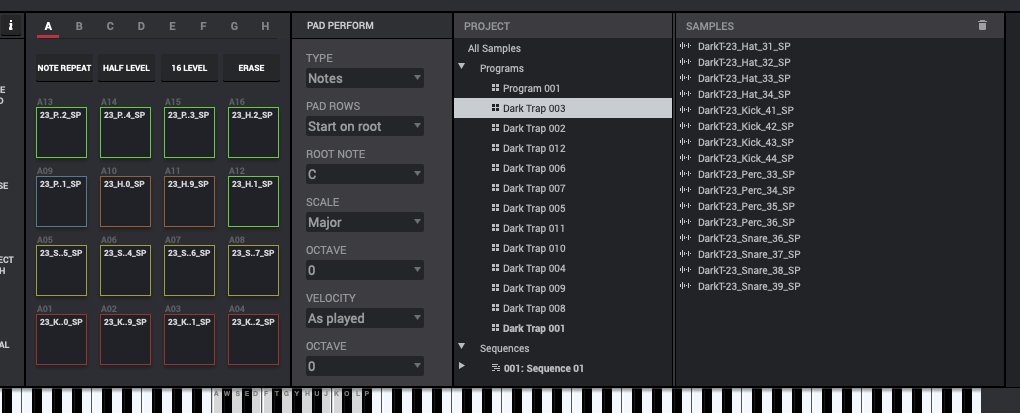
Important: The MPC 2 app only allows .wav files with a 44100 sample rate.
MPC Hardware (MPC Live, MPC X, MPC One & Akai Force)
View the Kit Maker: MPC Video for overview and instructions.
Transfer the processed kits to your MPC. Watch the video or see your MPC model’s manual for info on how to do this. Once the kits are on your MPC, the .xpm program files are ready to load as presets.
Important: MPCs only allow .wav files with a 44.1k sample rate.
Ableton Live
View the Kit Maker: Ableton Video for overview and instructions on creating Ableton drum kits.
Once processed, Ableton kits can be found in your User Library.
User Library > Presets > Instruments > Kit Maker Kits
Sample files are stored in the User Library
User Library>Samples>Imported>Kit Maker Samples
Tip: To make your kits quick to access in the future, drag the Kit Maker Kits folder to your Places sidebar in Ableton.
If you want to re-process the same library over again (for example: you changed your mind and wanted to use a different layout etc), you will first need to delete that library from both the Kit Maker Samples folder and Kit Maker Kits folder inside the User Library. Then you can process the library again.
The imported samples must be kept in your Ableton User Library. Custom Ableton User Library locations are compatible with Kit Maker. Having your User Library on an external drive can be helpful if your local hard drive is low on space.
Do you use a custom location for your Ableton User Library? You will need to link to that folder in the Kit Maker Preferences. Visit this page for more info on Ableton drum kits and custom User Library locations.
Ableton accepted sample audio file formats: .wav, .aiff, .mp3
Ableton Push
Kits can be used with Ableton Push, including Ableton Push 3. For standalone users, check out our video on how to transfer Ableton kits onto Push 3 Standalone.
EG Pulse
To use EG Pulse kits, transfer them to your iOS device and open the Files app on your device. You will need to have the kits on your actual device (not on a cloud server like Dropbox) in order for them to open correctly (EG Pulse may throw an error otherwise).
Open each kit one at a time. Each time you load a kit, it will be added to your list of available kits (but the currently loaded kit will not show up in the list immediately). Leave EG Pulse and go back to the Files app and open another kit and so on. After loading each kit, the previously loaded kits should show up in your list of kits. Unfortunately EG Pulse does not currently seem to have a way of importing multiple kits at a time.
Numbered Files
Kits made of numbered files are useful in software that can load samples sequentially.

Software that works well with the Numbered Files option is listed below.
View the Numbered Files page for visual instructions on how to import the files into these DAWs
- iMPC 2 (iOS)
- Bitwig Studio
- Geist2
- Groove Agent 5
- Kong – Reason drum device
- Umpf – Reason drum device (note: the Umpf device only has 8 pads)
- Logic Pro X – Drum Machine Designer (note: make sure your Logic software is updated)
- Roland SP404 MKII (note that the pads are numbered differently than the visual grid for this product)
- Novation Circuit Tracks / Rhythm
Transferring to iOS Devices
You can transfer your kits to your iOS in a few different ways.
The first is using iTunes File Transfer.
If you are on Mac and have Catalina, you can use the new Files software to transfer files to your device.
Another way is by using the Files app or transferring using a Cloud services such as iCloud or Dropbox. Each iOS app imports files a little differently. View our videos or consult each apps’ manual on importing files if you have issues.
